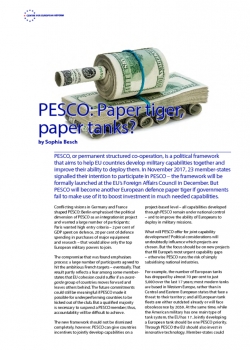
PESCO: Paper tiger, paper tanks?
PESCO, or permanent structured co-operation, is a political framework that aims to help EU countries develop military capabilities together and improve their ability to deploy them. In November 2017, 23 member-states signalled their intention to participate in PESCO – the framework will be formally launched at the EU’s Foreign Affairs Council in December. But PESCO will become another European defence paper tiger if governments fail to make use of it to boost investment in much needed capabilities.
Conflicting visions in Germany and France shaped PESCO: Berlin emphasised the political dimension of PESCO as an integrationist project and wanted a large number of participants; Paris wanted high entry criteria – 2 per cent of GDP spent on defence, 20 per cent of defence spending in purchases of major equipment and research – that would allow only the top European military powers to join.
The launch of #PESCO in December is hailed a political success, but for EU defence it is where the work begins.
The compromise that was found emphasises process: a large number of participants agreed to hit the ambitious French targets – eventually. That result partly reflects a fear among some member-states that EU cohesion could suffer if an avant-garde group of countries moves forward and leaves others behind. The future commitments could still be meaningful if PESCO made it possible for underperforming countries to be kicked out of the club. But a qualified majority is necessary to suspend a PESCO member; thus, accountability will be difficult to achieve.
The new framework should not be dismissed completely, however. PESCO can give countries incentives to jointly develop capabilities on a project-based level – all capabilities developed through PESCO remain under national control – and to improve the ability of Europeans to deploy in military missions.
What will PESCO offer for joint capability development? Political considerations will undoubtedly influence which projects are chosen. But the focus should be on new projects that fill Europe’s most urgent capability gaps – otherwise PESCO runs the risk of simply subsidising national industries.
For example, the number of European tanks has dropped by almost 70 per cent to just 5,000 over the last 17 years; most modern tanks are based in Western Europe, rather than in Central and Eastern European states that face a threat to their territory; and all European tank fleets are either outdated already or will face obsolescence by 2030. At the same time, while the American military has one main type of tank system, the EU has 17. Jointly developing a European tank should be one PESCO priority. Through PESCO the EU should also invest in innovative technology. Member-states could develop a European Medium-Altitude Long Endurance (MALE) drone. But given American dominance of that market and the fact that many European forces already have MALE drone fleets, they should instead invest in the development of High-Altitude Long Endurance (HALE) drones.
The #PESCO focus should be on new projects that fill Europe’s most urgent capability gaps.
But military hard-power development projects cost money. It is likely that PESCO will primarily be used for projects on the ‘softer’ end of the capability spectrum: a medical command centre, for example, should be easy to agree on.
One key job for policy-makers is to make sure PESCO aligns with other EU initiatives as well as with NATO’s defence planning process. The EU is already launching the co-ordinated annual review on defence (CARD) process, which compares national defence spending plans and identifies opportunities for new collaborative initiatives. It has also launched the European Defence Fund (EUDF), through which the European Commission wants to fund co-operative European defence research and capability development. It is crucial that the EU and NATO work closely together to avoid NATO priorities contradicting those of the EU.
Could the UK get involved in PESCO after it has left the EU? The framework does allow for third states to participate in projects if they provide “substantial added value”. But third countries will have no say in the choice of projects, and it is unlikely that they would be eligible to receive EU funding. In the future, any joint platform development that includes the UK might instead take place through inter-governmental organisations, such as through OCCAR, the organisation for joint armament co-operation.
One key job for policy-makers is to make sure #PESCO aligns with other EU initiatives.
Will PESCO make it easier for Europeans to launch military operations and missions together? It is important to note that the PESCO commitment does not cover a standing force, a readiness force, or a stand-by force: in other words, PESCO is no EU army. The hope is that common commitments, increased co-operation, and jointly developed capabilities – in particular joint training centres – will make it easier for EU militaries to deploy together. And PESCO members promise that they will reform the EU’s funding mechanism for joint operations, which places the brunt of an operation’s financial burden on the deploying country.
But well-known obstacles to joint missions and operations remain. European countries have different military cultures and lack a shared view of the threat environment. And while PESCO member-states say they want to create a fast-tracked political mechanism to generate forces, it will be difficult for some countries to follow through: Germany for example has an extensive parliamentary approval mechanism that makes rapid deployment of forces difficult. And PESCO is not legally binding: there is no guarantee that PESCO member-states will commit forces in a crisis.
The launch of PESCO in December is hailed as a political success; but for European defence it is where the work begins.
Sophia Besch is a research fellow at the Centre for European Reform.

